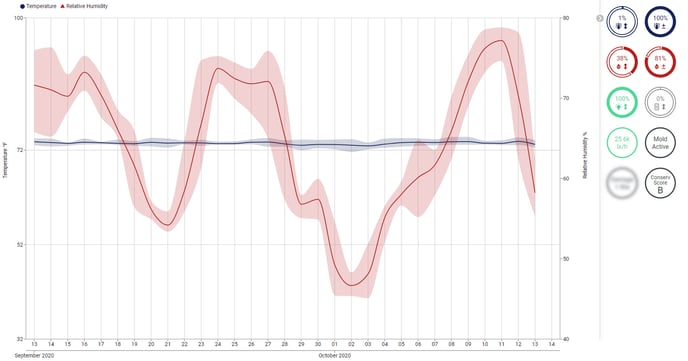Mold Risk Score
Understand the conditions in your spaces and take preventive measures to stop mold growth before it starts.
Mold risk calculations
The data that is collected from your sensors can help calculate the mold risk factor—a model that was developed by the Image Permanence Institute. This model evaluates how temperature and humidity readings over time impact mold growth, helping you make informed decisions about your spaces.
Mold risk is calculated using the cumulative impact of many temperature and relative humidity (RH) readings over time.
Mold risk increases as the favorable conditions for mold growth persist over time. Mold risk decreases as more time is spent in conditions that are unfavorable for mold growth.
As a general guideline, mold spores begin to germinate when RH exceeds 65%. To manage mold risk, aim to keep RH levels below this threshold. However, other factors, like airflow and a history of mold growth, can also influence mold risk.
Mold Risk Scores
We begin by calculating the mold risk score for each sensor reading, focusing on temperature and RH. "Favorable" conditions for mold growth are defined as temperatures between 2-45°C (35.6-113°F) and RH above 65%. Using the same lookup tables and formulas as the Image Permanence Institute's Dew Point Calculator, we calculate Days to Mold (DTM) and then determine the Mold Growth Rate (MGR) as 1/DTM.
MGR = 1/Days to Mold (DTM)
The MGR is then multiplied by the reading time (in days) to give a time-weighted sum number called Growth over Reading Period (GoRP).
GoRP = MGR * Reading time (in days)
The GoRP is added over the chosen period of time to get the mold risk score as shown in the following table. As the number increases from zero, mold risks increase. When the number is over one, it is likely that mold is already active.
Caution
You do not have to wait until you hit 1.0 or more for the possibility of mold in your spaces. You can expect mold when the mold risk score is 0.5 or more.
| Mold Risk Score | Mold Risk Status |
| 0 | None |
| 0 - 0.50 | Low |
| 0.50 - 1.00 | Medium |
| 1.0 | High |
| > 1.0 | Active |
Importantly, if the conditions are unfavorable for mold for 24 straight hours, the mold risk score is reset to zero.
Tip
Visually document mold with the Conserv Cloud Observations feature.
The following example shows a space that likely has active mold. It is difficult to see this from the chart, but the mold risk score quantifies the risk at a glance.

Mold Risk and Microclimates
Mold germination can be hyper localized, meaning that you might have two sensors in the same space—one indicating active mold risk while the other shows low or no risk. Therefore, Conserv does not recommend aggregating data from multiple sensors within the same area when assessing mold risk.
Conserv is currently evaluating enhancements for the metrics that are presented in both the weekly emails and summary reports. However, the best way to assess mold risk at this time is through individual sensor analytics.
Next Steps
With the mold risk score, you can align your team on the status of your collection and initiate discussions on necessary improvements. The primary purpose of effective metrics is not only to provide answers but also to foster better questions that address the root causes of issues.
Know Your Spaces
It is important to remember that your mold risk score is derived from a model that relies on certain assumptions about mold spore germination and focuses solely on temperature and humidity over time. This model has its limitations. A low mold risk score does not guarantee that mold will not develop, as numerous variables are not considered in this assessment, such as previous outbreaks, how often or how well your areas are dusted, and how good your airflow and air purity are.
For these reasons, it is essential to remain vigilant and familiarize yourself with your spaces, their history, and your building. Mold risk, much like other performance metrics, serves as a quantified simplification to guide your analysis of the data, but it should not be viewed as an absolute measure.
Additional Information
- Mold Spores are Ubiquitous: Mold spores are present in the air everywhere, lying in wait on surfaces for the right conditions to germinate, such as darkness, humidity, warmth, and organic matter to feed on.
- Past Outbreaks and Risk: A history of mold outbreaks may indicate a higher risk due to more spores in your space, but a lack of past outbreaks does not eliminate the possibility of a future one.
- Inorganic Surfaces: Contrary to popular belief, mold can grow on inorganic surfaces. Mold feeds on organic debris, such as dust and dirt, that may accumulate on these surfaces.
- Control Measures: If maintaining temperature and humidity control is challenging and mold risk is elevated, focus on constant vigilance, good ventilation and cleanliness to reduce the likelihood of mold growth.